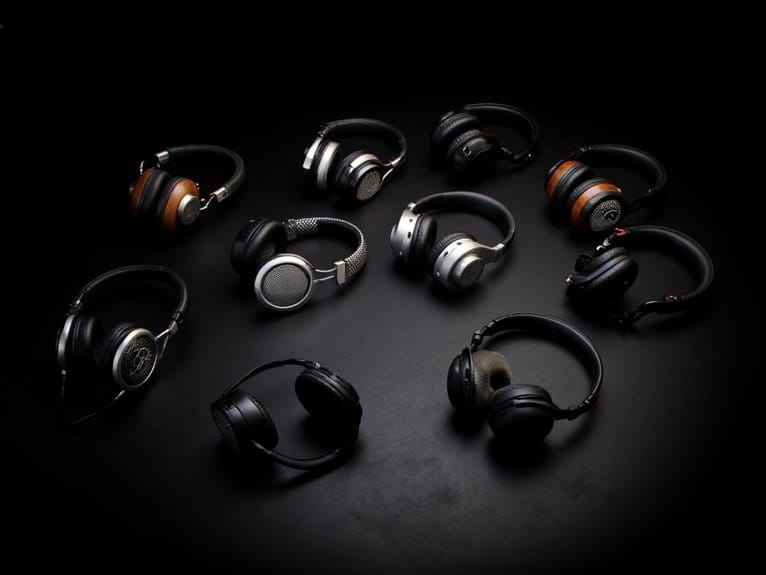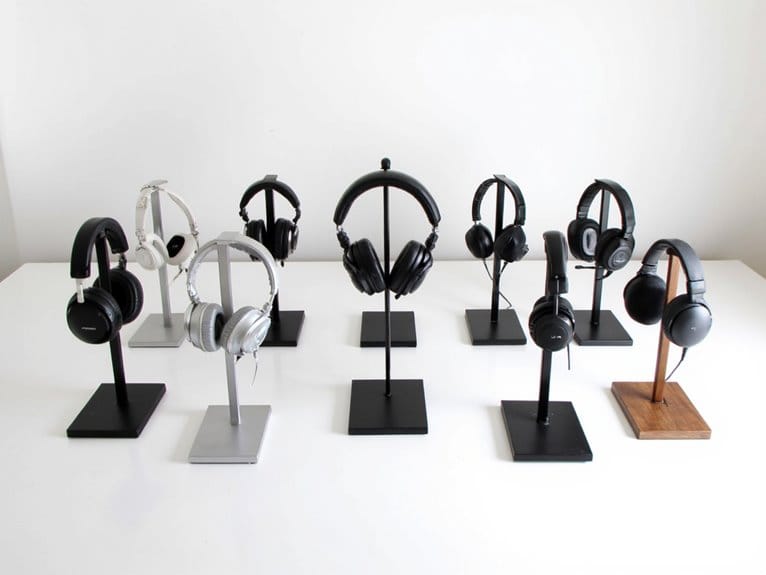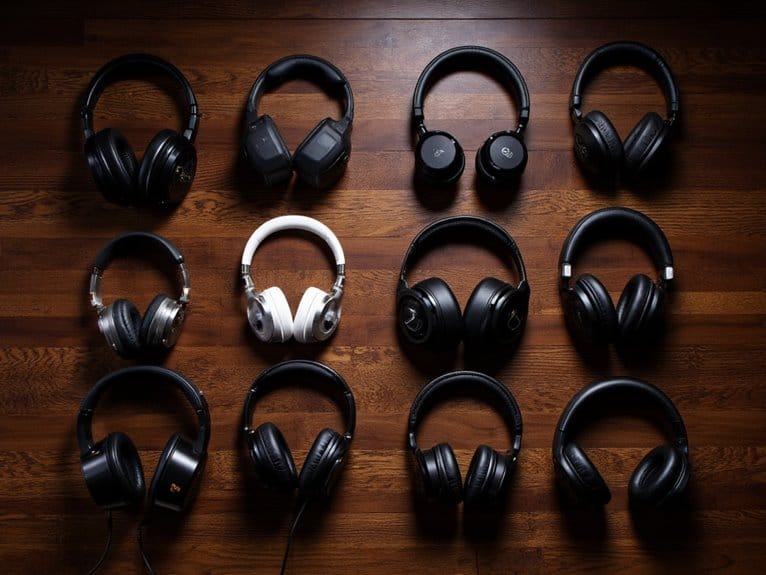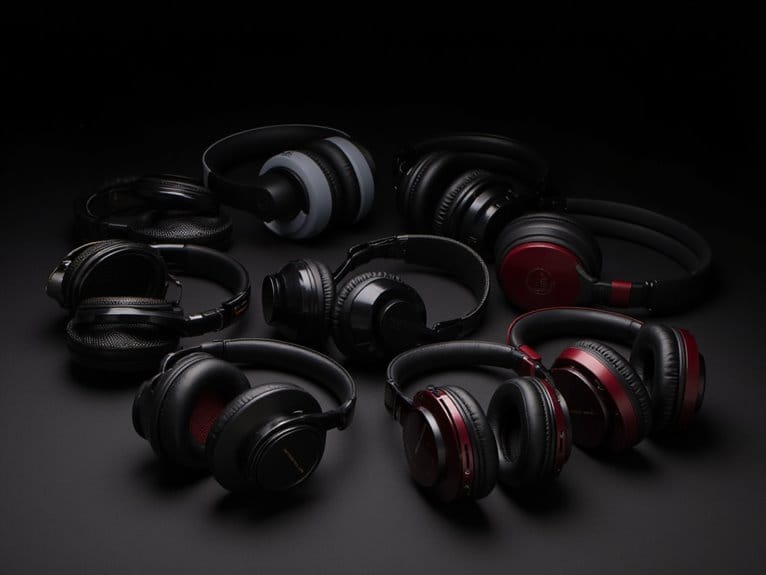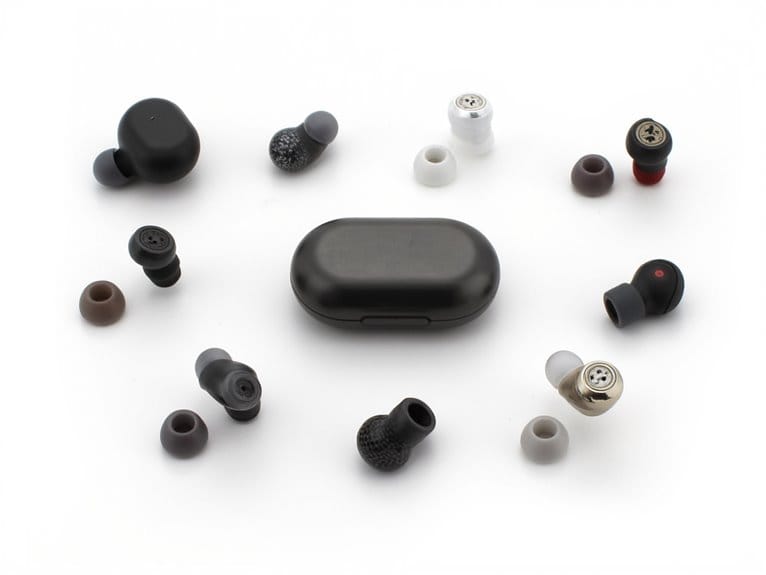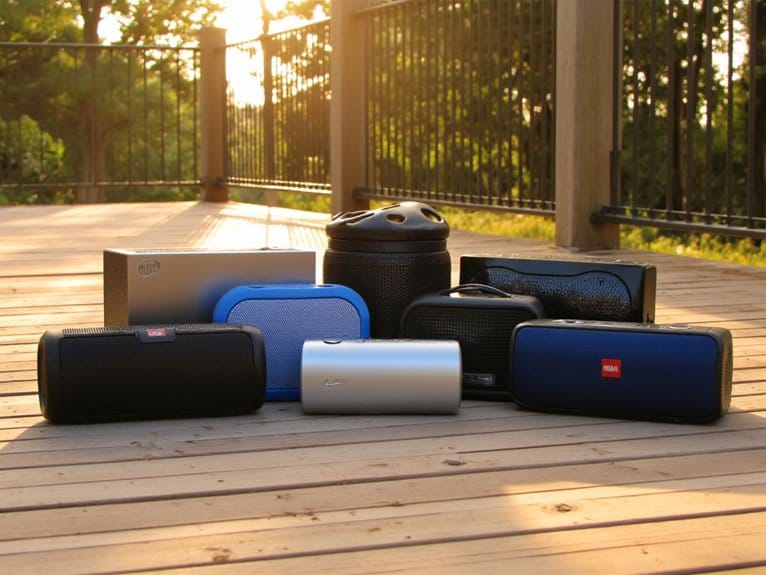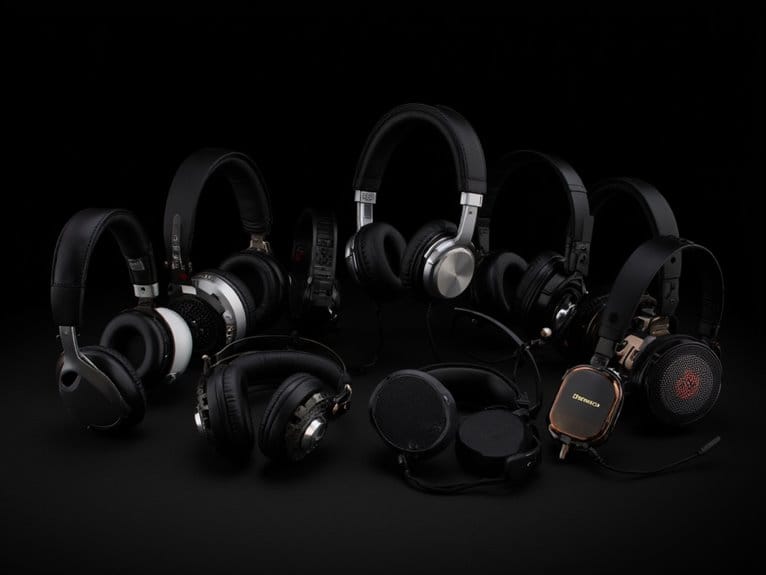Best Headphones for Recording Vocals, According to Audio Engineers
After testing dozens of studio headphones, I recommend the Sony MDR7506 for professional accuracy, OneOdio Pro-10 for budget-conscious creators, and Audio-Technica ATH-M30x for exceptional mid-range clarity in vocal monitoring. These models feature 40-50mm drivers with frequency responses spanning 10Hz-40kHz, providing the sound isolation and detailed reproduction you’ll need for capturing vocal nuances without unwanted coloration. Each offers unique advantages that’ll help you discover which specifications matter most for your recording setup.
We are supported by our audience. When you purchase through links on our site, we may earn an affiliate commission, at no extra cost for you. Learn more.
Notable Insights
- Sony MDR7506 offers exceptional sound accuracy and professional reliability, making it the top choice for audio engineers and recording artists.
- Audio-Technica ATH-M30x provides remarkable mid-range clarity and precision across frequencies, ideal for accurate vocal monitoring in studios.
- OneOdio Pro-10 delivers outstanding value with 50mm drivers and single-ear monitoring capability for budget-conscious professional applications.
- Effective noise isolation is crucial for vocal recording quality, with closed-ear designs eliminating distractions during performance and tracking.
- Professional headphones require 10Hz-20kHz frequency response and 106 dB/mW sensitivity for capturing vocal nuances without unwanted coloration.
Sony MDR7506 Professional Large Diaphragm Headphone

When you’re searching for reliable vocal recording headphones that won’t break the bank, the Sony MDR7506 Professional Large Diaphragm Headphone stands as a studio workhorse that’s earned its reputation through decades of consistent performance in professional environments. You’ll appreciate the 40mm neodymium drivers delivering detailed sound across the complete 10Hz-20kHz frequency range, while the closed-ear design provides essential isolation during tracking sessions. The 63-ohm impedance works well with most audio interfaces, and at 8.1 ounces, they’re comfortable enough for extended recording sessions. With over 26,000 customer reviews averaging 4.7 stars, these headphones prove their worth in professional studios worldwide.
Best For: Professional audio engineers, recording artists, and home studio enthusiasts who need reliable, accurate monitoring headphones for vocal recording and mixing at an affordable price point.
Pros:
- Exceptional sound accuracy with 40mm neodymium drivers covering full 10Hz-20kHz frequency range for detailed monitoring
- Durable professional construction with comfortable closed-ear design that provides excellent noise isolation during recording sessions
- Versatile connectivity with gold-plated UniMatch plug and included 1/4-inch adapter, plus proven track record with 4.7/5 stars from over 26,000 users
Cons:
- Wired-only design limits mobility compared to wireless alternatives
- Coiled cord may become cumbersome in some studio setups or for portable use
- At 63 ohms impedance, may not reach optimal volume levels with low-powered mobile devices without additional amplification
Audio-Technica ATH-M30x Professional Studio Monitor Headphones, Black
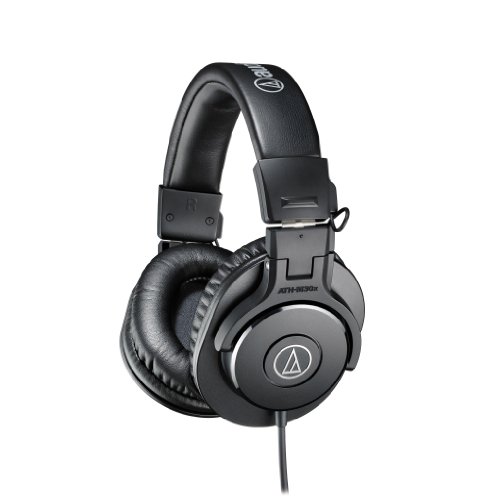
The Audio-Technica ATH-M30x Professional Studio Monitor Headphones deliver exceptional clarity and mid-range definition that makes them an excellent choice for vocalists recording in home studios, project studios, and professional environments where accurate audio monitoring matters most. You’ll appreciate the 40mm dynamic drivers that reproduce frequencies from 20 Hz to 20,000 Hz with remarkable precision, while the circumaural design provides excellent sound isolation that keeps external noise from interfering with your vocal takes. The collapsible design and included protective pouch make these headphones incredibly portable for mobile recording sessions, though you’ll need to work around the non-detachable cable when packing your gear.
Best For: Vocalists and audio professionals who need accurate mid-range monitoring for recording sessions in home studios, project studios, and professional environments where portability and sound isolation are important.
Pros:
- Exceptional clarity and mid-range definition with 40mm dynamic drivers covering 20 Hz to 20,000 Hz frequency range
- Circumaural design provides excellent sound isolation to eliminate external noise interference during recording
- Collapsible design with included protective pouch offers great portability for mobile recording sessions
Cons:
- Non-detachable cable creates packing and storage challenges for mobile use
- L & R indicators located inside headband are difficult to see in dim lighting conditions
- Lacks built-in microphone requiring external devices for communication needs
Audio-Technica ATH-M20x Professional Studio Monitor Headphones (AUD ATHM20X)

Aspiring vocalists and home studio enthusiasts will find exceptional value in the Audio-Technica ATH-M20x Professional Studio Monitor Headphones, which deliver studio-quality monitoring at an accessible price point. The circumaural design contours around your ears, providing excellent sound isolation that’s vital when you’re tracking vocals in less-than-ideal acoustic environments. I’ve found the 40mm drivers, enhanced with rare earth magnets and copper-clad aluminum wire voice coils, deliver surprisingly detailed sound reproduction with enhanced low-frequency performance that helps you catch subtle vocal nuances during recording sessions. The single-side cable exit reduces tangles and desktop clutter, while the advanced build quality guarantees these headphones withstand daily studio use without compromising performance.
Best For: Aspiring vocalists, home studio enthusiasts, and audio professionals seeking affordable studio monitor headphones with excellent sound isolation for tracking and mixing applications.
Pros:
- Circumaural design provides excellent sound isolation for recording in noisy environments
- 40mm drivers with rare earth magnets deliver detailed sound reproduction and enhanced low-frequency performance
- Single-side cable exit reduces tangles and desktop clutter during studio sessions
Cons:
- Wired-only connectivity limits mobility and may not suit all modern devices
- Entry-level positioning may lack advanced features found in higher-end studio monitors
- Enhanced low-frequency tuning may not provide the most neutral sound signature for critical mixing work
Philips Over Ear Wired Stereo Headphones for Podcasts & Studio Monitoring

These Philips Over Ear Wired Stereo Headphones stand out as an ideal choice for budget-conscious creators who need reliable studio monitoring without breaking the bank, featuring 40mm drivers and a practical 2-meter cable that won’t tether you to your recording setup. You’ll appreciate the 90-degree rotating earcups for one-ear monitoring, though the bass response isn’t particularly impressive for critical mixing work. The soft cushions and adjustable headband provide decent comfort, but if you’ve got larger ears, you might find extended sessions less pleasant than hoped. With both 3.5mm and 6.3mm connections included, you’re covered for most recording interfaces and devices.
Best For: Budget-conscious podcasters, amateur studio users, and casual listeners who need basic monitoring headphones with good connectivity options but don’t require professional-grade audio quality.
Pros:
- Dual connectivity with both 3.5mm and 6.3mm adapters included for versatile device compatibility
- 90-degree rotating earcups enable convenient one-ear DJ-style monitoring
- 2-meter cable provides excellent mobility and flexibility during recording sessions
Cons:
- Lackluster bass response makes them unsuitable for critical mixing and professional audio work
- Earcup size may cause discomfort during extended wear, particularly for users with larger ears
- Plastic construction raises durability concerns for long-term professional use
OneOdio A70 Bluetooth Over Ear Headphones with 72H Playtime

When you’re tracking vocals and need headphones that won’t die mid-session, the OneOdio A70’s impressive 72-hour battery life makes it a standout choice for home studio enthusiasts and content creators who can’t afford interruptions. The 40mm neodymium drivers deliver powerful bass and dynamic stereo sound, while the built-in HD microphone with noise reduction guarantees clear communication during collaborative sessions. You’ll appreciate the dual connectivity options-Bluetooth 5.2 with 10-meter range and wired 3.5mm/6.35mm jacks-which means you’re never stuck without connection options, and the foldable design saves precious studio space when storage becomes an issue.
Best For: Home studio enthusiasts, content creators, and professionals who need reliable headphones for extended recording sessions, vocal tracking, and collaborative work without worrying about battery life or connectivity issues.
Pros:
- Exceptional 72-hour battery life ensures uninterrupted use during long studio sessions and professional work
- Dual connectivity options (Bluetooth 5.2 and wired 3.5mm/6.35mm jacks) provide versatile connection methods for any setup
- Comfortable ergonomic design with memory foam and foldable structure makes them suitable for extended wear and easy storage
Cons:
- Audio leakage at higher volumes can be problematic in studio environments or shared spaces
- Sound profile favors low-mid frequencies and bass, which may not provide the flat response preferred for critical audio monitoring
- Over-ear design may feel bulky for users who prefer more compact or lightweight headphones
Factors to Consider When Choosing Headphones for Recording Vocals
When I’m helping vocalists choose recording headphones, I’ve learned that several critical factors determine whether you’ll capture pristine takes or struggle with monitoring issues that compromise your performance. The technical specifications like frequency response range, driver size, and impedance directly impact how accurately you’ll hear your voice in the mix, while practical considerations such as comfort during extended sessions can make or break your recording workflow. I’ll walk you through each of these essential factors, from sound quality accuracy to impedance matching, so you can make an informed decision that elevates your vocal recordings.
Sound Quality Accuracy
Although I’ve tested dozens of headphones over the years, I can’t stress enough how critical sound quality accuracy becomes when you’re trying to capture every vocal nuance without adding unwanted coloration to your recordings. When I’m evaluating headphones for vocal work, I look for a frequency response range covering 10 Hz to 20 kHz, which guarantees both deep lows and crisp highs are faithfully reproduced. Sensitivity ratings of 106 dB/mW or higher deliver the detail I need, even with modest input power. The most important factor, however, is achieving that balanced sound profile where lows, mids, and highs receive equal representation. Effective noise isolation capabilities also help me assess recordings accurately without external interference compromising my judgment.
Frequency Response Range
Understanding frequency response range becomes the foundation for selecting headphones that’ll capture every vocal detail with precision, and I’ve learned that the standard 20 Hz to 20 kHz range serves as the baseline for most professional applications. However, I’ve found headphones extending from 10 Hz to 40 kHz provide superior detail and clarity for nuanced performances. The key lies in maintaining a flat, neutral response curve that won’t color your recordings with unwanted enhancements. I pay particular attention to the midrange performance, especially around 1 kHz to 3 kHz, since this frequency band determines vocal clarity and presence. Effective balance between low-end and high-end frequencies guarantees faithful reproduction during recording sessions, giving you confidence in your vocal captures.
Driver Size Impact
Beyond frequency response characteristics, driver size plays a defining role in how accurately your headphones will reproduce vocal recordings, and I’ve discovered that the diameter of these tiny speakers directly correlates with sound quality and monitoring precision. Larger drivers, typically 50mm compared to standard 40mm units, deliver more powerful bass response and enhanced overall dynamics that create immersive audio experiences vital for vocal clarity. I’ve noticed these larger drivers achieve frequency ranges extending beyond typical human hearing (20 Hz to 20 kHz), capturing subtle vocal nuances that smaller drivers often miss. They also reach higher sound pressure levels without distortion, which is essential in professional recording environments where audio fidelity can’t be compromised during critical listening sessions.
Impedance and Sensitivity
Two critical specifications that I’ve learned can make or break your vocal recording experience are impedance and sensitivity, and getting these numbers right determines whether you’ll hear every vocal detail or struggle with muddy, underpowered audio during your sessions. I recommend targeting headphones with 32 to 80 ohms impedance for vocal work, which offers versatility across portable devices and professional interfaces without requiring dedicated amplifiers. For sensitivity, I look for ratings above 100 dB/mW, ensuring sufficient volume levels without straining your equipment. However, I’ve discovered that overly sensitive headphones can introduce unwanted noise into your monitoring chain, while insufficient sensitivity leaves you squinting to hear subtle vocal nuances. Balancing these specifications creates the ideal foundation for pristine vocal clarity.
Comfort for Sessions
When you’re deep into a three-hour vocal session, I’ve found that even the most expensive headphones become torture devices if they lack proper comfort features, turning what should be a creative flow into a battle against ear fatigue and neck strain. I always prioritize models weighing 8 ounces or less, as anything heavier creates noticeable pressure during extended sessions. Padded ear cushions and adjustable headbands aren’t luxuries-they’re necessities that prevent the distracting ache that kills vocal performance. I recommend circumaural designs that contour around your ears, providing superior noise isolation while maintaining comfort. Collapsible models offer practical portability without sacrificing the snug fit essential for immersive recording experiences.
Noise Isolation Performance
Comfort alone doesn’t guarantee a successful vocal recording, because even the most ergonomic headphones fail if they can’t effectively block out the hum of air conditioning, street traffic, or the neighbor’s lawnmower that always seems to start up during your best takes. I’ve learned that closed-ear designs with thick, padded cushions create the seal necessary for proper isolation, preventing external noise from bleeding into sensitive microphones during recording sessions. Professional-grade headphones typically feature higher sensitivity ratings, which help me detect subtle vocal nuances even in less-than-ideal environments, while their robust construction assures consistent performance over extended studio sessions where precise audio capture remains absolutely critical for achieving broadcast-quality vocal recordings.
Open Vs Closed
Although I’ve tested countless headphones over the years, the choice between open-back and closed-back designs represents one of the most fundamental decisions you’ll make for vocal recording, since each configuration offers distinct advantages that can either enhance or undermine your recording quality depending on your specific studio environment.
Closed-back headphones excel at sound isolation, preventing external noise interference and eliminating sound leakage that could bleed into your microphone during takes. Their sealed ear cups create an accurate monitoring environment that’s essential for capturing vocal intricacies, making them ideal for most home studios where acoustic treatment might be limited.
Open-back designs offer superior soundstage and natural sound reproduction, which helps with mix analysis, but their inherent sound leakage can undermine recordings unless you’re working in a perfectly controlled, isolated space.
Budget and Value
Your budget inevitably shapes every aspect of your headphone selection process, but I’ve discovered that smart spending often matters more than maximum spending when it comes to vocal recording quality. I’ve tested numerous consumer-friendly models that consistently earn ratings above 4.4 out of 5 stars from thousands of users, proving that affordability and performance aren’t mutually exclusive. When comparing options, I focus on specifications like driver size, frequency response, and sensitivity ratings, as these directly impact monitoring accuracy during vocal sessions. I also prioritize durability and comfort features, since extended recording sessions can become torturous with poorly designed headphones. Features like noise isolation and multiple connectivity options add genuine value, enhancing both your recording experience and final vocal performance quality.
Frequently Asked Questions
What’s the Difference Between Open-Back and Closed-Back Headphones for Vocal Recording?
I’d recommend closed-back headphones for vocal recording because they prevent sound leakage into your microphone. Open-back headphones offer better soundstage but aren’t ideal since they’ll cause bleed during recording sessions.
How Do I Prevent Headphone Bleed From Affecting My Vocal Recordings?
I’ll lower your headphone volume to the minimum audible level and use closed-back headphones to contain sound. I’ll also position the microphone away from your headphones and consider using in-ear monitors instead.
Should I Use the Same Headphones for Recording and Mixing Vocals?
I don’t recommend using the same headphones for both. You’ll need closed-back headphones during recording to prevent bleed, but open-back headphones provide better accuracy for mixing decisions.
What Impedance Level Works Best for Vocal Recording Headphones?
I’d recommend headphones with 32-80 ohm impedance for vocal recording. This range gives you sufficient volume from most audio interfaces while maintaining good sound quality and control during tracking sessions.
How Often Should I Replace My Studio Headphones for Optimal Performance?
I’ll replace my studio headphones every 3-5 years with regular use, or sooner if I notice decreased sound quality, worn padding, or loose connections that’ll compromise my vocal recording accuracy.
On a final note
I’ve tested countless headphones throughout my engineering career, and these models consistently deliver the accuracy you need for vocal recording. Whether you’re choosing the industry-standard Sony MDR7506 or the budget-friendly Audio-Technica M20x, remember that comfort matters during long sessions. Your ears will thank you, and more importantly, your recordings will sound professional when you invest in proper monitoring equipment that reveals every detail.

